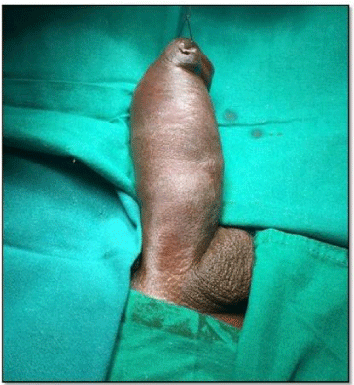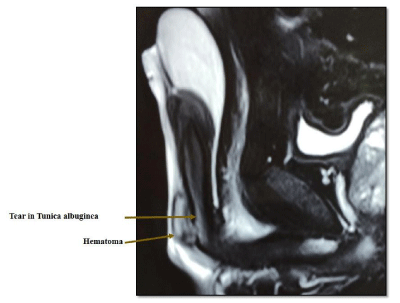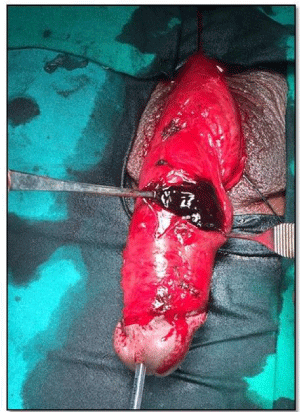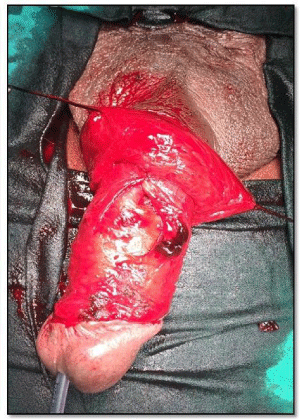Open Journal of Trauma
Long Term Outcome of Patients with Penile Fracture Undergoing Delayed Repair
Rajendra B Nerli*, Vikas Sharma, Amit Mungarwadi, Nitin D Pingale, Ameya T Wagh, Siddharth M Sarnaik and Anvesh A
Cite this as
Rajendra NB, Vikas S, Amit M, Nitin PD, Wagh AT, et al. (2017) Long Term Outcome of Patients with Penile Fracture Undergoing Delayed Repair. Open J Trauma 1(2): 032-036. DOI: 10.17352/ojt.000008Introduction: Fracture of the penis is a rare urological emergency which occurs as a result of abrupt trauma to an erect penis. Immediate surgical repair is the standard of care and is superior to non-operative management due to excellent long term outcomes. A large percentage of the patients present late for treatment out of fear or embarrassment. We report our series of patients who presented late and underwent delayed repair. We also report the long term outcome in these patients.
Materials & Methods: The data was retrospectively collected from hospital records, which included: detailed history, symptoms, type of relationship, mechanism of trauma, sexual position, clinical findings at physical examination, imaging results, presence of urethral injury, outcomes, and long-term complications regarding sexual and voiding functions.
Results: Twenty two patients presented to our hospital casualty/emergency services following penile fracture and underwent delayed surgical repair. Heterosexual inter- course was the most common cause of fracture (18 patients, 81.81%). The mean time duration between injury and presentation was 48.77±33.56 hours. The mean time duration between presentation and surgical intervention was 4.31±1.37 hours. MRI was done in 6 cases with positive predictive value of 100%. Seventeen (77.27%) patients experienced erections during the post-operative period in the hospital. At the end of 1 year follow-up all the 22 patients had been having sexual intercourse.
Conclusions: Our data suggests that, patients with penile fractures undergoing delayed repair have preservation of erectile potency and overall sexual function is maintained.
Introduction
Penile fracture typically occurs when the engorged and erect penile corpora are forced to buckle and literally “pop” under the pressure of a blunt sexual trauma. Although cavernosal lacerations to the flaccid penis can occur as a result of gunshot traumas and sporting injuries, it is accepted that injuries to the flaccid penis are not regarded as “fractures,” owing to the different nature of the injury [1,2]. Anatomically, the flaccid penis lacks a fulcrum for snapping and contains relatively thick tunica albuginea, protecting it from internal rupture under strain. In contrast, the tunica of the erect penis thins to approximately 0.25 mm on expansion, and the firmly engorged corpora under the strain of buckling can generate pressures in excess of 1500 mm Hg and exceed the limit of the thinned tunica [3,4]. Malis [5], described the first case of a penile fracture in the literature in 1924.
Although initially it was believed to be a relatively rare injury, fracture of the penis has been increasingly reported. A review by Eke, identified more than 1600 cases in the world literature, with more than half of those cases originating from Islamic countries [4,6]. The largest single series to date describes 172 cases over 9 years in a single province of Iran [4,7]. The majority of cases of fracture penis occur as the result of traumatic coitus, usually from thrusting an erect penis against the symphysis pubis or perineum [8,9]. In Japan, only 19% of cases are attributed to sexual intercourse, with the vast majority of cases reported as the result of masturbation and rolling over in bed onto an erect penis [10].
The diagnosis of penile fracture is usually based on a good history and physical examination. Some investigators have recommended the use of ultrasound, carvernosography and magnetic resonance imaging (MRI) to image and locate the site of the tunical tear before surgery [11,12]. However, the positive predictive values in these studies has been shown to be similar to that of history and clinical examination [13]. Penile fracture is a urological emergency and immediate surgical exploration with repair offers the best chance of healing with preservation of erectile function [14]. Although immediate surgical repair has been recommended by most authors, delayed repair is possible and has been suggested in situations in which accurate localization of the fracture site is clinically not evident or the patient presents late. Gross penile swelling decreases rapidly, and by 7-12 days, the clot at the fracture site is easily palpable and is often visible. Naraynsingh and Raju [15], described the ‘‘rolling sign’’ for early identification of the fracture site, even when the penis is quite swollen. We report our series of patients with delayed presentation of fracture penis and managed with surgical repair. We also report the short and long term outcome in these patients.
Materials & Methods
All patients presenting with clinical suspicion of penile fracture were included in this study, following the best ethics criteria according to the University/Institutional ethical committee. The necessary data was retrospectively collected from patients’ records, which included: detailed history, symptoms, type of relationship (homosexual/heterosexual), mechanism of trauma, sexual position (when applied), clinical findings at physical examination, imaging results (when requested by the clinical judgment of the urologist), presence of urethral injury, outcomes, and long-term complications regarding sexual and voiding functions.
Results
We retrospectively reviewed all medical records of patients presenting with penile fracture between January 1996 to December 20015. Inclusion criteria included patients presenting to our hospital casualty/emergency services at least 24 hours after sustaining injury, fracture occurring with the penis in erect position, and having received no active treatment at any other institution.
Twenty two patients fulfilled the inclusion criteria. (Table 1) shows detailed clinical findings of the patients. Heterosexual inter-course was the most common cause of fracture (18 patients, 81.81%), followed by penile manipulation (2 patients, 9.09%) and homosexual intercourse (1 patients, 4.54%). One patient (4.54%) opted to maintain the cause unclear. The reasons for delay is as shown in Table 2.
Preoperative ultrasonography was done in 8 patients with positive predictive value of 75 %. In two cases the ultrasonography was unable to detect the site of cavernosal defect. MRI was done in 6 cases with positive predictive value of 100%. All the fractures affected one of the two corpora and the mean size of the tear was 1.7 cm. Urethral tear was noted in one case which was confirmed on urethrogram. There was no correlation between injury extension and mechanism (sexual position, etc.).
All the patients attended follow-up visits to the hospital at around 4 weeks, 12 weeks and at the end of 1 year. All the patients were advised to avoid active sexual intercourse for about 12 weeks. Seventeen (77.27%) patients had experienced erections during the post-operative period in the hospital. At the end of 1 year follow-up all the 22 patients had been having sexual intercourse. The one patient who had urethral injury and had undergone repair of the same during the repair of penile fracture was voiding well and had a maximum flow rate of 19 ml/sec. None of the 22 patients had bending of the penis.
Fifteen of these patients could be contacted in July 2015 and were able to answer the International Index of Erectile Function (IIEF-5) questionnaire. Of these 15 patients, 13 (86.66%) have been sexually active since then. All these 13 patients reported that their erections were hard enough to achieve and maintain penetration most or all of the time. Two (13.34%) patients found it difficult or very difficult to maintain an erection for intercourse. These patients were using sildenafil 50 mg on a regular basis. Thirteen (86.6%) patients reported attempts at sexual inter-course as being satisfactory most or all of the time. These patients demonstrated no evidence of erectile dysfunction (IIEF-5 >22), 1 patient reported symptoms of mild ED (IIEF-5, 17-21) and 1 patient reported mild to moderate ED (IIEF-5 range: 12-16). Patients did not complain of any bending of penis in erect and non-erect positions.
Discussion
The diagnosis of penile fracture is often straight forward and can be made reliably by history and physical examination. Patients usually describe a cracking or popping sound as the tunica tears, followed by pain, rapid detumescence, discoloration and swelling of the penile shaft. If the Buck fascia remains intact, the penile hematoma remains contained between the skin and tunica, resulting in a typical eggplant deformity (Figure 1). Fear and embarrassment are commonly associated with such injuries, hence the patient’s presentation to the emergency department or clinic is sometimes significantly delayed.
Urethral injury can occur though infrequently, hence preoperative urethrography should be considered whenever urethral injury is suspected. Kamdar et al [16], have suggested performing intraoperative flexible cystoscopy routinely just before catheter placement at the time of penile exploration. Magnetic resonance imaging (MRI) (Figure 2) is a noninvasive and accurate means of demonstrating disruption of the tunica albuginea [17]. The increased cost, limited availability, and time requirements involved with the study have limited its routine use in assessing these injuries. However it would be reasonable to use MRI in the evaluation of patients without the typical presentation and physical findings of penile fracture.
Management involves prompt exploration and surgical repair of penile fractures (Figures 3,4) as reported in several contemporary publications [18]. Immediate surgical reconstruction results in faster recovery, decreased morbidity, lower complication rates, and lower incidence of long-term penile curvature [18,19]. Although immediate repair results in penile curvature in less than 5% of patients [18], conservative management of penile fracture has been associated with penile curvature in more than 10% of patients , abscess or debilitating plaques in 25% to 30%, and significantly longer hospitalization times and recovery [18]. Asgari et al. [20], reported that the timing of surgery may also influence long-term success - those undergoing repair within 8 hours of injury had significantly better long-term results than did those having surgery delayed 36 hours after the fracture occurred.
Naraynsingh et al. [21], reported on a patient who definitely benefited from the late repair. The patient had presented with painful erection and angulation of the penis more than 3 weeks after sustaining an injury to his penis. They also believe that simple repair however delayed is associated with good outcome. Zargooshi [7] reported on the long term outcome of surgical repair in 170 patients with a mean age of 27 years. The mean time interval between injury and presentation was 22 hours and between presentation and repair was 10 hours. Complications occurred in eight patients (4.7%), of whom seven developed a mild (four) to moderate (three) penile curvature; five had penile nodules and four reported mild paresthesia over the scar line. Mild to moderate erectile dysfunction (ED) was reported by eight patients. Of the eight patients with ED, seven responded to intracavernosal injection with papaverine /phentolamine. Erectile function returned within a mean (range) of 2 (1-5) days and coitus was possible approximately 2 weeks after the repair.
Nason et al. [22], assessed the overall sexual function following fracture of the penis in 21 patients. A voluntary telephone questionnaire was performed to assess long term outcomes using three validated questionnaires-the Erection Hardness Grading Scale, the International Index of Erectile Function (IIEF-5) and the Brief Male Sexual Function inventory (BMSFI). Seventeen patients were contactable. Fourteen patients demonstrated no evidence of erectile dysfunction, 1 patient reported symptoms of mild ED and one patient reported mild to moderate ED. No patients reported insufficient erection for penetration (EHGS: 1 or 2). Regarding the overall BMSFI, 13 (83%) patients were mostly satisfied or very satisfied with their sex life within the previous month.
The long-term effects of delayed presentations and the optimal timing of subsequent intervention have caused some debate. Our study demonstrates that delayed repair does not in any way affect the long term outcome in these patients. Kozacioglu and colleagues [23], reported no serious deformity or ED as a consequence of delay in surgery within a given time frame in 56 penile fractures, in terms of number of hours to presentation (mean number of hours from trauma to repair 11.3 ± 8.5 hours). Similarly , el-Assmy and colleagues [24], noted no difference in serious long- term complications between those who were treated surgically following an early (within 24 hours) or delayed (up to 7 days) presentation. Of their cohort, 17% presented as delayed fractures.
Erection hardness and implied erection function is one of the main determinants involved in male sexual function. The International Index of Erectile Function (IIEF-5) is an abbreviated questionnaire focusing on erectile function and intercourse satisfaction for the diagnosis of the presence and severity of erectile dysfunction (ED) (5 questions, maximum score 25) [25]. Erection hardness is a fundamental component of erection function. The Erection Hardness Grading Scale (EHGS) is a single question, a 4-point scale for ED, which provides a reliable measure of erection hardness [26]. The Brief Male Sexual Function Inventory (BMSFI) provides a self- reported measure of current sexual functioning. It covers three functional domains (sexual drive, erectile function and ejaculatory function), as well as problem assessment of these functional domains and overall satisfaction [27]. Our data too suggests that, in our cohort of penile fractures following sexual intercourse, long-term erectile potency is preserved and overall sexual function is maintained.
Surgery has been shown to reduce the incidence of penile fracture complications, however 6% to 25% of patients still experience long-term sequelae after surgery [6]. Reported long- term sequelae after penile fracture repair include: penile deviation, painful intercourse, painful erection, erectile dysfunction, priapism, skin necrosis, arteriovenous fistula, urethrocavernous fistula, and urethral stricture [6].
Conclusion
In our small series of men with penile fracture managed within a short time frame after presentation, erectile potency is maintained and long-term overall sexual satisfaction is promising irrespective of the time of surgical repair.
- Jallu A, Wani NA, Rashid PA (1980) Fracture of the penis. J Urol 123: 285-286. Link: https://goo.gl/J34i08
- Godec CJ, Reiser R, Logush AZ (1988) The erect penis–injury prone organ. J Trauma 28: 124-126. Link: https://goo.gl/ZWpIvn
- Schonberger B (1982) Verletzungen der mannlichen Gentitalorgane. Z Urol Nephrol 75: 879. Link: https://goo.gl/utsPnU
- Jack GS, Garraway I, Reznichek R, Rajfer J (2004) Current Treatment Options for Penile Fractures. Rev Urol 6: 114-120. Link: https://goo.gl/YganKZ
- Malis J (1924) Zur Kausuistik der fractura penis. Arch Klin Chir 129: 651. Link: https://goo.gl/fwdDCr
- Eke N (2002) Fracture of the penis. Br J Surg 89: 555-565. Link: https://goo.gl/aSy1Zo
- Zargooshi J (2000) Penile fracture in Kermanshah, Iran: report of 172 cases. J Urol 164: 364-366. Link: https://goo.gl/VC9XzQ
- Nicoliasen GS, Melamud A, McAninch JW, Williams RD (1983) Rupture of the corpus cavernosum: surgical management. J Urol 130: 917-919. Link: https://goo.gl/Yn8VAm
- Shetty M, Nerli RB, Kamat S, Sadalge A, Patil VK, et al. (2004) Penile fractures: Results of delayed repair. Ind J Urol 20: 123-125. Link: https://goo.gl/KqwpgF
- Ishikawa T, Fujisawa M, Tamada H, Inoue T, Shimatani N (2003) Fracture of the penis: nine cases with evaluation of reported cases in Japan. Int J Urol 10: 257-260. Link: https://goo.gl/z8LmIq
- Pruthi RS, Petrus CD, Nidess R, Venable DD (2000) Penile fracture of the proximal corporeal body. J Urol 164: 447-448. Link: https://goo.gl/dlDVIY
- Abolyosr A, Moneim AE, Abdelatif AM, Abdalla MA, Imam HM (2005) The management of penile fracture based on clinical and magnetic resonance imaging findings. BJU Int 72: 373-377. Link: https://goo.gl/q7lRvD
- Mydlo JH, Hayyeri M, Macchia RJ (1998) Urethrography and carvernosography imaging in a small series of penile fractures: a comparison with surgical findings. Urology 51: 616-619. Link: https://goo.gl/zaodgY
- Mensah JE, Morton B, Kyei M (2010) Early surgical repair of penile fractures. Ghana Med J 44: 119-122. Link: https://goo.gl/BvF2MQ
- Naraynsingh V, Raju GC (1985) Fracture of the penis. Br J Surg 72: 305-306. Link: https://goo.gl/pr4zgY
- Kamdar C, Mooppan UMM, Kim H, Gulmi FA (2008) Penile fracture: preoperative evaluation and surgical technique for optimal patient outcome. BJU Int 102: 1640-1644. Link: https://goo.gl/Gsp4cc
- Uder M, Gohl D, Takahashi M, Derouet H, Defreyne L, et al. (2002) MRI of penile fracture: diagnosis and therapeutic follow-up Euro Radiol 12: 113-120. Link: https://goo.gl/yqeIPG
- Morey AF, Dugi DD Genital and Lower Urinary Tract Trauma. In Wein AJ, Kavoussi LR, Novick AC, Partin AW, Peter CA (2015) Ed Campbell-Walsh Urology. 11th Ed, Elsevier-Saunders, Philadelphia, 201: 2507-2520. Link: https://goo.gl/3VqxMG
- El-Taher AM, Aboul-Ella HA, Sayed MA, Gaafar AA (2004) Management of penile fracture. J Trauma 56: 1138-1140. Link: https://goo.gl/LN10hj
- Asgari MA, Hossieni SY, Safarinejad MR, Samadzadeh B, Bardideh AR (1996) Penile fracture: evaluation, therapeutic approaches and long term results. J Urol 155: 148-149. Link: https://goo.gl/UcxUKl
- Naraynsingh V, Hariharan S, Goetz L, Dan D (2010) Late Delayed Repair of Fractured Penis. J Androl 31: 231-233. Link: https://goo.gl/KkuePc
- Nason GJ, McGuire BB, Liddy S, Looney A, Lennon GM, et al. (2013) Sexual function outcomes following fracture of the penis. Can Urol Assoc J 7: 252-257. Link: https://goo.gl/7zAnxN
- Kozacioglu Z, Degirmenci T, Arslan M, Yuksel MB, Gunlusoy B, et al. (2011) Long-term significance of the number of hours until surgical repair of penile fractures. Urol Int 87: 75-79. Link: https://goo.gl/DSyDSa
- el-Assmy A, el-Tholoth HS, Mohsen T, Ibrahiem el-HI (2011) Does timing of presentation of penile fracture affect outcome of surgical intervention? Urology 77: 1388-1391. Link: https://goo.gl/AJ5L1M
- Rosen RC, Cappelleri JC, Smith MD, Lipsky J, Peña BM (1999) Development and Evaluation of an Abridged, 5-Item Version of the International Index of Erectile Function (IIEF-5) as a Diagnostic Tool for Erectile Dysfunction. Int J Imp Res 11: 319-326. Link: https://goo.gl/axdaOE
- Mulhall JP, Goldstein I, Bushmakin AG, Cappelleri JC, Hvidsten K (2007) Validation of erection hardness score. J Sex Med 4: 1626-1634. Link: https://goo.gl/ir6v3m
- O'Leary MP, Fowler FJ, Lenderking WR, Barber B, Sagnier PP, et al. (1995) A brief male sexual function inventory in urology. Urology 46: 697-706. Link: https://goo.gl/9o5qUh
Article Alerts
Subscribe to our articles alerts and stay tuned.
 This work is licensed under a Creative Commons Attribution 4.0 International License.
This work is licensed under a Creative Commons Attribution 4.0 International License.





 Save to Mendeley
Save to Mendeley
